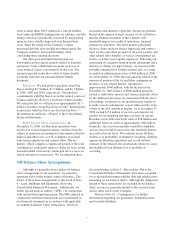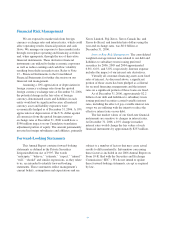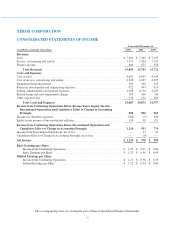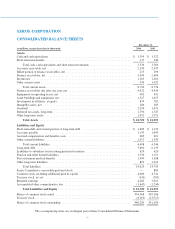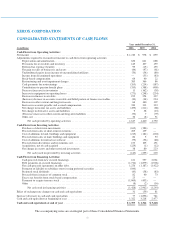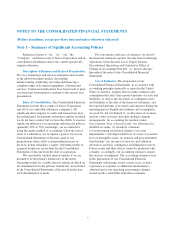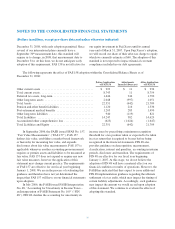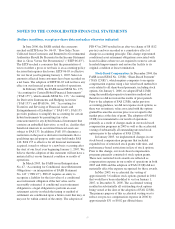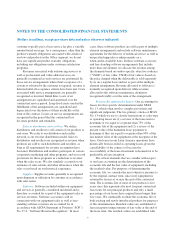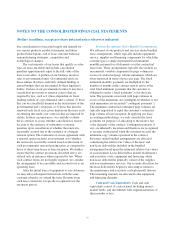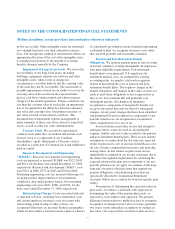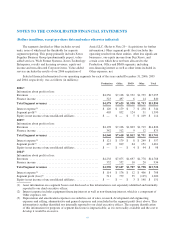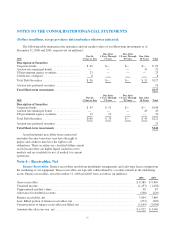Xerox 2006 Annual Report Download - page 60
Download and view the complete annual report
Please find page 60 of the 2006 Xerox annual report below. You can navigate through the pages in the report by either clicking on the pages listed below, or by using the keyword search tool below to find specific information within the annual report.
NOTES TO THE CONSOLIDATED FINANCIAL STATEMENTS
(Dollars in millions, except per-share data and unless otherwise indicated)
Stock-based compensation expense for the three
years ended December 31, 2006 was as follows (in
millions):
2006 2005 2004
Stock-based compensation expense,
pre-tax ....................... $64 $40 $22
Stock-based compensation expense,
netoftax ..................... 39 25 13
FAS 123(R) requires that the cash flows from the tax
benefits resulting from tax deductions in excess of the
compensation cost recognized for stock-based awards
(excess tax benefits) be classified as financing cash flows.
Prior to the adoption of FAS 123(R), such excess tax
benefits were presented as operating cash flows.
Accordingly, $25 excess tax benefits has been classified as
a financing cash inflow for the year ended December 31,
2006 in the Consolidated Statements of Cash Flows. Such
excess tax benefits amounted to $12 and $23 for the years
ended December 31, 2005 and 2004, respectively and are
included in operating cash flows.
Prior to January 1, 2006, in accordance with APB
Opinion No. 25 “Accounting for Stock Issued to
Employees,” we did not recognize compensation expense
relating to employee stock options because the exercise
price was equal to the market price at the date of grant. If
we had elected to recognize compensation expense using
a fair value approach as required by FAS 123(R), and
therefore determined the compensation based on the value
as determined by the modified Black-Scholes option
pricing model, our pro forma income and earnings per
share would have been as follows:
(in millions, except per share data) 2005 2004
Net income – as reported .............................................................. $978 $859
Add: Stock-based employee compensation expense included in reported net income, net of tax ....... 25 13
Deduct: Total stock-based employee compensation expense determined under fair value based method
for all awards, net of tax ............................................................. (113) (82)
Net income – pro forma ............................................................... $890 $790
Basic EPS – as reported ............................................................... $0.96 $0.94
Basic EPS – pro forma ................................................................ 0.87 0.86
Diluted EPS – as reported .............................................................. $0.94 $0.86
Diluted EPS – pro forma .............................................................. 0.85 0.80
The weighted-average fair value of options granted
in 2004 was $8.38. The 2004 fair values were estimated
on the date of grant using the following weighted average
assumptions: risk-free interest rate of 3.2%; expected life
of 5.7 years; expected price volatility of 66.5%; and no
expected dividend yield.
Refer to Note 18 – Common Stock for additional
disclosures regarding our stock compensation programs.
Summary of Accounting Policies:
Revenue Recognition: We generate revenue
through the sale and rental of equipment, service and
supplies and income associated with the financing of our
equipment sales. Revenue is recognized when earned.
More specifically, revenue related to sales of our products
and services is recognized as follows:
Equipment: Revenues from the sale of equipment,
including those from sales-type leases, are recognized at
the time of sale or at the inception of the lease, as
appropriate. For equipment sales that require us to install
the product at the customer location, revenue is
recognized when the equipment has been delivered to and
installed at the customer location. Sales of customer
installable products are recognized upon shipment or
receipt by the customer according to the customer’s
shipping terms. Revenues from equipment under other
leases and similar arrangements are accounted for by the
operating lease method and are recognized as earned over
the lease term, which is generally on a straight-line basis.
Service: Service revenues are derived primarily from
maintenance contracts on our equipment sold to
customers and are recognized over the term of the
contracts. A substantial portion of our products are sold
with full service maintenance agreements for which the
58


